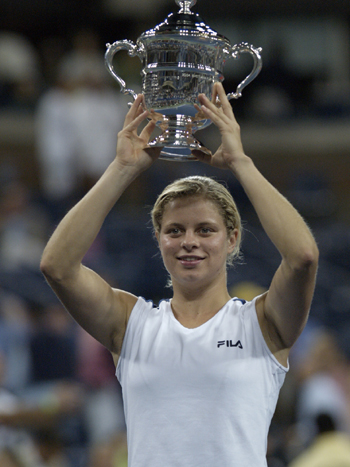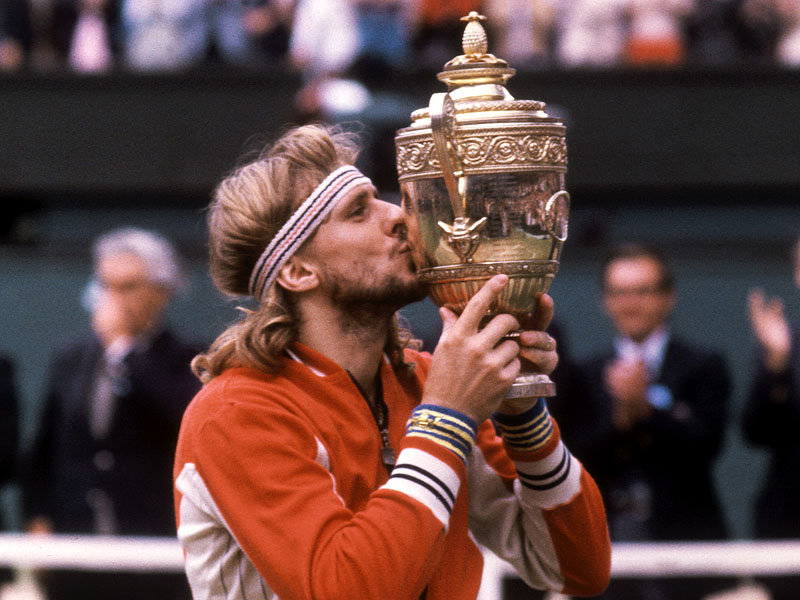Clijsters is the reigning singles champion at the US Open and the Australian Open. She has also won 41 WTA singles titles and 11 WTA doubles titles. She has won four Grand Slam singles titles: three at the US Open, in 2005, 2009 and 2010 and one at the Australian Open in 2011. She has also been runner-up in four Grand Slam singles tournaments, and won the WTA Tour Championships singles title in 2002, 2003 and 2010. In doubles, she won the French Open and Wimbledon titles in 2003. Clijsters announced her retirement with immediate effect on 6 May 2007,[3] but almost two years later, on 26 March 2009, she publicly declared her intent to return to the WTA tour for the 2009 summer hard court season.[4] In only her third tournament back, she won her second US Open title, becoming the first unseeded player and wildcard to win the tournament, and the first mother to win a major since Evonne Goolagong in 1980
Playing style
Clijsters is recognized for her deep, powerful, well-placed groundstrokes. She can hit outright winners off both wings and from any part of the court. Her forehand is one of the best and most powerful the women's game has ever seen, yet occasionally erratic and prone to unforced errors; her backhand is more reliable and consistent, and can be hit with heavy slice as a defensive shot. Clijsters is also recognised for her all-court defence, characterized by speed and athleticism. Clijsters, along with Jelena Janković and Svetlana Kuznetsova, is among the few tennis players on either the Association of Tennis Professionals or Women's Tennis Association tours who can slide (or "straddle") on all surfaces. Maria Sharapova, interviewed after losing to Clijsters in the 2005 Nasdaq-100 Open, said, "You just have to expect that she's going to get every ball back". Her first serve, while not overwhelming, is placed well and earns aces and unreturnables. Clijsters tends to rush between first and second serves, which may contribute to her occasional matches with high numbers of double faults. A former World No. 1 player in doubles, Clijsters has exceptional volleys; she has no problem switching from baseline to finishing points at the net with a volley or over-head. Her mental fragility was considered her biggest weakness, and at the earlier stages of her career she was considered a "choker", often surrendering big leads in the latter rounds of Grand Slams.[citation needed] Since winning the 2005 US Open, Clijsters has gained more control over her nerves and since her return to the tour in 2009 she has been known, along with Serena Williams, as among the toughest players to beat mentally. She is now seen as capable of rising to the occasion and playing her best tennis at the important stages of matches. Clijsters is also considered to be one of the most popular players on the tour, known for her grace on the court and even temper. She has been voted the WTA Karen Krantzcke Sportsmanship Award by her fellow players seven times and the WTA Player Service Award three times.
Personal life
Clijsters was born on 8 June 1983, in Bilzen, Limburg, in the Flemish Region of Belgium. She is the daughter of Lei Clijsters, a former international footballer, and Els Vandecaetsbeek, a former national gymnastics champion. Lei Clijsters died of skin cancer on 4 January 2009.[8] Clijsters says that she inherited footballer's legs from her father and a gymnast's flexibility from her mother.[9] Kim's younger sister Elke finished 2002 as the ITF World Junior Doubles champion and retired in 2004 after back injuries.
In December 2003, Clijsters announced her engagement to Australian Lleyton Hewitt, but their relationship ended in October 2004.[10] Clijsters is still affectionately nicknamed "Aussie Kim" by Australians. In October 2006, Clijsters announced her engagement to American basketball player Brian Lynch, who is based in Kim's hometown of Bree. In an interview with Sportweekend (a sports programme on Belgian Flemish television), Clijsters said that she was retiring to start a family.[3] Clijsters and Lynch married privately on 13 July 2007, at 6 a.m. at the Bree city hall. She was married by the mayor, with sister Elke, Lynch's brother Pat Lynch, and both sets of parents present.
Clijsters gave birth to a daughter on 27 February 2008, at 1:35 pm at the Vesalius hospital in Tongeren, Belgium. The girl, Jada Ellie, weighed 3.035 kg and measured 51 cm.
 kim clijsters hot pics
kim clijsters hot pics kim clijsters hot pics
kim clijsters hot pics kim clijsters hot pics
kim clijsters hot pics kim clijsters hot pics
kim clijsters hot pics kim clijsters hot pics
kim clijsters hot pics kim clijsters hot pics
kim clijsters hot pics kim clijsters hot pics
kim clijsters hot pics kim clijsters hot pics
kim clijsters hot pics kim clijsters hot pics
kim clijsters hot pics kim clijsters hot pics
kim clijsters hot pics








































